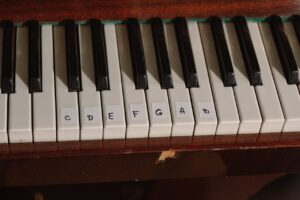For musicians, particularly pianists, the distinction between chords and scales is fundamental to mastering the instrument. Chords and scales are the building blocks of music, each with a unique role in creating harmony and melody.
Therefore, understanding the differences between piano chords and scales is a necessary step in becoming a well-rounded musician.
This article explains the differences between piano chords and scales and explores their unique characteristics and roles in musical composition.
- Fall in love with the music - Learn your favorite songs, at a level suitable for you.
- Enjoy interactive piano lessons - Explore courses covering music theory, technique chords & more.
- Get real-time feedback - Skoove's feedback tells you what went well and what needs practice.

What are piano chords?
- A chord is typically composed of three or more notes played together.
- Unlike scales, which are sequential, chords are about the vertical stacking of notes.
- The basic structure of a chord involves at least three notes, known as a triad, which typically includes the root note, a third, and a fifth.
Types of chords
The most common type of piano chords are called triads. Triads have three notes. The most common types of triads are:
- Major chords
- Minor chords
- Diminished chords
- Augmented chords
Each of these chords has a particular sound and color associated with it.
Construction of chords
Chords, and triads in particular, are built from musical intervals called “thirds.” To make a triad, we stack two thirds on top of each other.
For example, a major chord is a major third followed by a minor third. A minor chord is a minor third followed by a major third. This means that the A major chord is spelled A – C♯ – E and the A minor chord is spelled A – C – E.
Understanding piano scales
A scale, on the other hand, is a series of notes arranged in ascending or descending order, spanning an octave.
Each piano scale is built upon a specific pattern of intervals, typically consisting of whole steps (whole tones) and half steps (semitones), as opposed to stacked thirds like the triads.
The fundamental characteristic of a scale is its tonality or key, which establishes the ‘home’ note or tonic around which the scale is centered.
Types of scales
Scales can be categorized into several types, each with its unique structure and emotional impact:
- Major scales: The major scale is perhaps the most familiar and widely used scale in Western music. It consists of a specific pattern of whole and half steps, resulting in a bright and uplifting sound.
- Minor scales: Minor scales are characterized by their melancholic or introspective quality. There are several variations of minor scales, including natural minor, harmonic minor, and melodic minor, each with its distinct interval pattern.
- Pentatonic scales: Pentatonic scales feature five notes per octave and are prevalent in various musical traditions worldwide. They are valued for their simplicity and versatility and are often used in improvisation and folk music.
Differences between chords and scales
Chords and scales are often used when mastering the piano. But how exactly do they differ? Here are a few instances that contrast the two:
Harmonic vs. melodic function
The primary difference between chords and scales lies in their roles in music. Chords serve a harmonic function in music and create the background for the melodic material.
Scales, on the other hand, serve a melodic function. While scales and chords are interrelated, it is from scales that we pull the material to form melodies.
Chord construction vs. scale patterns
Chords, especially triads, are built by stacking thirds on top of a root note, creating a set of notes that are played simultaneously.
Scales are constructed based on a series of intervals moving stepwise in a particular order, which can be whole steps, half steps, or a combination of both. Scales and arpeggios are played in sequential order, while all the notes of a chord are played simultaneously.
Usage in composition and performance
In composition, chords and scales play distinct yet interrelated roles. Chords are often used to establish the harmonic foundation of a piece, setting the stage for the melody.
They are crucial in genres like pop, rock, and classical, where harmony dictates the structure of the music. Scales are used to craft melodies and solos, especially in genres like jazz and blues, where improvisation is key. A deep understanding of scales allows performers to navigate through complex chord changes and create compelling solos that are both inventive and harmonically sound.
In performance, the knowledge of both chords and scales is essential. A pianist might use chords to accompany a singer or another instrument, providing the harmonic context for the melody. Meanwhile, scales are used for soloing, embellishing melodies, and even for warm-up exercises to develop finger dexterity and speed.
In this video, we are taken through how chords and scales are related. The clip comprehensively covers how chords and scales are related to each other, why you can use multiple scales over a single chord, and also responding to the question why certain scales sound good over certain chords.
For example, the video talks about the chord CMaj13 being in the key of C Major because it uses every single note in the C Major Scale: C, E, G, B, D, F, A. Also, C13 is in the key of F Major because it uses every single note in the F Major Scale: C, E, G, Bb, D, F, A
Exercises to practice chords and scales
Check out these popular exercises that can help you get your groove on:
- Chord progression practice: Work on common chord progressions in various keys, such as the I-IV-V progression in major keys or the i-iv-V progression in minor keys. Practice transitioning smoothly between chords and maintaining a steady rhythm.
- Chord inversions: Practice playing chords in different inversions across the keyboard. This helps develop finger dexterity and familiarity with chord voicings, allowing for smoother transitions between chords in different contexts.
- Scale exercises: Practice scales in all keys, both ascending and descending, using proper fingering techniques. Start slowly and gradually increase the tempo as you become more comfortable. Focus on playing scales evenly and smoothly, paying attention to articulation and tone quality.
- Scale patterns: Explore different scale patterns, such as scales in thirds, arpeggios, and scale runs. These exercises help improve coordination between the hands and develop fluency in navigating the keyboard.
- Chord arpeggios: Practice arpeggiating chords in various rhythms and patterns. Experiment with different articulations, dynamics, and tempos to develop control and expression in your playing.
Learning piano chords and scales is not complicated and you can get started in no time. A Quora user wanted to know how someone can start learning to play chords and scales for the first time when learning how to play piano.
There were many responses, but one of the comments that stood out advised the individual first to learn music theory to acquaint themselves with basic notes, keys, and modes. Thereafter, you can learn chord theory, including aspects like chord progression and the different basic chords. Through practice, you get to understand the key difference in the chords.
After this, you can follow the same process to learn scales too. While playing scales and chords, you should pay closer attention to the intervals. Eventually, practice makes perfect.
However, there are a few tips you may have to consider to incorporate both like a pro:
- Integrate chords and scales: Incorporate chords and scales into your daily practice routine, dedicating specific time to each. Start by warming up with scales to improve finger agility, and then move on to practicing chords, chord progressions, or easy piano songs.
- Practice with a purpose: Focus on specific goals when practicing chords and scales, such as mastering a particular chord progression or scale pattern.
Break down complex passages into smaller sections and practice them slowly and methodically before gradually increasing the tempo. You can use a platform like Skoove, where you can get well-organized piano practices based on your unique needs.
- Utilize repetition: Repeat challenging chords and scale exercises regularly to reinforce muscle memory and improve accuracy. Repetition is key to internalizing patterns and building proficiency on the piano.
- Experiment with variations: Explore different ways of playing chords and scales, including dynamics, articulations, and rhythms. Experiment with improvisation and creative expression within the framework of chords and scales to develop your musicality.
By incorporating these exercises and tips into your piano practice routine, you can enhance your proficiency in playing chords and scales, ultimately leading to greater confidence and versatility in your musical expression.
Conclusion
Learning the differences between chords and scales is like learning the difference between pencil and pen. Both are used for writing, but they have different purposes. The same is true for chords and scales. We use chords and scales all the time for making music, but we need to understand when to use one and when to use the other.
If you are eager to embark on this path, Skoove offers an accessible platform to learn the piano at your own pace. With interactive lessons on mastering chords and scales, Skoove makes it easy for anyone to start their musical journey to master chords and scales on the piano!
Author of this blog post:
Susana Pérez Posada

With over seven years in piano education and a deep passion for music therapy, Susana brings a unique blend of expertise to Skoove. A graduate in Music Therapy from SRH Hochschule Heidelberg and an experienced classical pianist from Universidad EAFIT, she infuses her teaching with a holistic approach that transcends traditional piano lessons. In her writings for Skoove, Susana combines her rich musical knowledge with engaging storytelling, enriching the learning experience for pianists of all levels. Away from the piano, she loves exploring new places and immersing herself in a good book, believing these diverse experiences enhance her creative teaching style.
Published by Lydia Hovan from the Skoove team














